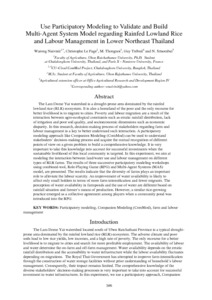Redistributive land reform and poverty reduction in South Africa
At the end of Apartheid, approximately 82 million hectares of commercial farmland (86% of total agricultural land, or 68% of the total surface area) was in the hands of the white minority (10.9% of the population), and concentrated in the hands of approximately 60,000 owners (Levin and Weiner 1991: 92). Over thirteen million black people, the majority of them poverty-stricken, remained crowded into the former homelands, where rights to land were generally unclear or contested and the system of land administration was in disarray (Hendricks 1990; Cousins 1996; Lahiff 2000).
Swaziland Poverty Reduction Strategy and Action Plan (PRSAP) 2007.
The present Poverty Reduction Strategy and Action Plan (PRSAP) 2007 provides the framework for poverty focused planning and budgeting in the short to medium term. Poverty reduction will be central to all sectoral development plans and the medium term expenditure framework. Part 3 defines the Overarching Policy Objective as follows: The overriding goal of the PRSAP is to reduce poverty by more than 50% by 2015 and then ultimately eradicate it by 2022.
Environmental Management (Soil Quality Standards) Regulations, 2007.
These Regulations, made by the Minister of State under sections 143, 144 and 230 of the Environmental Management Act, concern soil pollution and soil quality standards and provide with respect to a soil protection permit and compliance system. They also concern measures of enforcement.
Participatory Poverty Assessment II
This participatory poverty assessment (PPA 2006) comprises one component of ADB’s Technical Assistance to the Lao People’s Democratic Republic for Institutional Strengthening for Poverty Monitoring and Evaluation. The goal of this PPA, as with the first PPA in 2000, is to complement the statistical analyses of poverty in a meaningful way and to record the experiences and concerns of the poor in order to initiate and identify more effective forms of public and private actions to alleviate poverty.
Rural Credit Markets in Myanmar: A Study of Formal and Non-Formal Lenders
This paper conducts an empirical investigation of the rural credit market in Myanmar to help guide policy formulation on the microfinance operations in the country. Specifically, it looks into the determinants of credit demand and of rationing loans at the household level, and identifies the similarities, differences and relationships among the various segments of the rural creditmarket.Data are primarily gathered through a survey covering a total of 301 households among 7 villages in the Dry Zone.
Understanding the links between agriculture and health
Policymaking initiatives in agriculture and public health are often pursued in a parallel and unconnected fashion. Yet coherent, joint action in agriculture and health could have large potential benefits and substantially reduce risks for the poor. Among development professionals there is growing recognition that agriculture influences health, and health influences agriculture, and that both in turn have profound implications for poverty reduction.
URBANIZATION: IMPACTS ON THE EVOLUTION OF 'MIXED FARMING' SYSTEMS IN SUB-SAHARAN AFRICA
During the past two decades or so, rural population in Africa has increased slowly while urban population has grown dramatically. The hugely increased urban demand for cereals and pulses (which produce crop residues for livestock) and for livestock products is now the main force stimulating mixed farming systems in the semiarid and subhumid areas of subSaharan Africa. Grazing land has diminished, crop residues are becoming a more important element in raising livestock and fattening penned livestock has become profitable.
Stratégie des acteurs face à la multifonctionnalité : le cas de la Guadeloupe et de la Réunion
The multifunctionality of agriculture promoted by the Agriculture Act is difficult to reconcile with the intensive models dominant in Guadeloupe and Reunion. This is made clear by an analysis of the management rules and practices for territorial farming contracts, intended to implement this Act. The difficulty of this reconciliation can also be observed by the impact that the statute’s application has had on its targets — production units. We conducted open or conversation interviews with institutional personnel and with farmers who have signed these contracts.
Stakeholders’ strategies and multifunctionality : the case of Guadeloupe and Reunion Islands
The multifunctionality of agriculture promoted by the Agriculture Act is difficult to reconcile with the intensive models dominant in Guadeloupe and Reunion. This is made clear by an analysis of the management rules and practices for territorial farming contracts, intended to implement this Act. The difficulty of this reconciliation can also be observed by the impact that the statute’s application has had on its targets — production units. We conducted open or conversation interviews with institutional personnel and with farmers who have signed these contracts.
Stratégie des acteurs face à la multifonctionnalité : le cas de la Guadeloupe et de la Réunion
The multifunctionality of agriculture promoted by the Agriculture Act is difficult to reconcile with the intensive models dominant in Guadeloupe and Reunion. This is made clear by an analysis of the management rules and practices for territorial farming contracts, intended to implement this Act. The difficulty of this reconciliation can also be observed by the impact that the statute’s application has had on its targets — production units. We conducted open or conversation interviews with institutional personnel and with farmers who have signed these contracts.
foundations of planetary agrarianism. Thomas Berry and Liberty Hyde Bailey
The challenge of pursuing sustainability in agriculture is often viewed as mainly or wholly technical in nature, requiring the reform of farming methods and the development and adoption of alternative technologies. Likewise, the purpose of sustainability is frequently cast in utilitarian terms, as a means of protecting a valuable resource (i.e., soil) and of satisfying market demands for healthy, tasty food. Paul B. Thompson has argued that the embrace of these views by many in the consumer/environmental movement enables easy co-optation by agribusiness.







